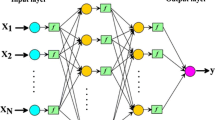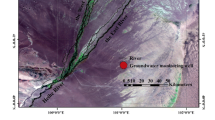Abstract
The prediction of water quality parameters plays an important role in water resources and environmental systems. The use of electrical conductivity (EC) as a water quality indicator is one of the important parameters for estimating the amount of mineralization. This study describes the application of artificial neural network (ANN) and wavelet–neural network hybrid (WANN) models to predict the monthly EC of the Asi River at the Demirköprü gauging station, Turkey. In the proposed hybrid WANN model, the discrete wavelet transform (DWT) was linked to the ANN model for EC prediction using a feed-forward back propagation (FFBP) training algorithm. For this purpose, the original time series of monthly EC and discharge (Q) values were decomposed to several sub-time series by DWT, and these sub-time series were then presented to the ANN model as an input dataset to predict the monthly EC. Comparing the values predicted by the models indicated that the performance of the proposed WANN model was better than the conventional ANN model. The correlation of determination (R 2) were 0.949 and 0.381 for the WANN and ANN models, respectively. The results indicate that the peak EC values predicted by the WANN model are closer to the observed values, and this model simulates the hysteresis phenomena at an acceptable level as well.








Similar content being viewed by others
References
Adamowski, J., & Chan, H. F. (2011). A wavelet neural network conjunction model for groundwater level forecasting. Journal of Hydrology, 407, 28–40.
Addison, P. S., Murrary, K. B., & Watson, J. N. (2001). Wavelet transform analysis of open channel wake flows. Journal of Engineering Mechanics, 127, 58–70.
Alagha, J., Said, M. A., & Mogheir, Y. (2014). Modeling of nitrate concentration in groundwater using artificial intelligence approach—a case study of Gaza coastal aquifer. Environmental Earth Science, 186(1), 35–45.
Altun, H., Bilgil, A., & Fidan, B. C. (2007). Treatment of multi-dimensional data to enhance neural network estimators in regression problems. Expert Systems with Applications, 32, 599–605.
Bishop, C. M. (1995). Neural networks for pattern recognition. Oxford: Clarendon. ISBN 978-3-642-57760-4.
Bruder, S., Babbar-Sebens, M., Tedesco, L., & Soyeux, E. (2014). Use of fuzzy logic models for prediction of taste and odor compounds in algal bloom-affected inland water bodies. Environmental Earth Sciences, 186(3), 1525–1545.
Camdevyren, H., Demyr, N., Kanik, A., & Keskyn, S. (2005). Use of principal component scores in multiple linear regression models for prediction of chlorophyll-an in reservoirs. Journal on Ecological Modelling, 181, 581–589.
Cannas, B., Fanni, A., Sias, G., Tronci, S., & Zedda, M. K. (2005). Stream flow forecasting using neural networks and wavelet analysis. Journal of the European Geoscience Union, 7, 45–51.
Civelekoglu, G., Yigit, N. O., Diamadopoulos, E., & Kitis, M. (2007). Prediction of bromate formation using multi-linear regression and artificial neural networks. Journal of Science and Engineering, 29, 353–362.
Cohen, A., & Kovacevic, J. (1996). Wavelets: the mathematical background. Proceedings of the IEEE, 84, 514–22.
Daliakopoulos, I., Coulibalya, P., & Tsani, I. K. (2005). Groundwater level forecasting using artificial neural network. Journal of Hydrology, 309, 229–240.
Daubechies, I. (1990). The wavelet transform, time–frequency localization and signal analysis. IEEE Transactions on Information Theory, 36(5), 961–1005.
Diamantopoulou, M. J., Antonopoulos, V. Z., & Papamichail, D. M. (2007). Cascade correlation artificial neural networks for estimating missing monthly values of water quality parameters in rivers. Journal of Water Resources Planning and Management, 21, 649–662.
Goh, A. T. C. (1995). Back-propagation neural networks for modeling complex systems. Journal for Artificial Intelligence in Engineering, 9, 143–151.
Hagan, M. T., & Menhaj, M. B. (1994). Training feed forward networks with the Marquardt algorithm. IEEE Transactions on Neural Networks, 6, 861–867.
Han, H. G., Chen, Q. L., & Qiao, J. F. (2011). An efficient self-organizing RBF neural network for water quality prediction. Journal of Neural Networks, 24, 717–725.
Haykin, S. (1999). Neural networks: a comprehensive foundation (2nd ed.). Englewood Cliffs, NJ: Prentice Hall.
Isik, F., & Ozden, G. (2013). Estimating compaction parameters of fine- and coarse-grained soils by means of artificial neural networks. Environmental Earth Science, 69, 2287–2297.
Karakaya, N., Evrendilek, F., Gungor, K., & Onal, D. (2013). Predicting diel, diurnal and nocturnal dynamics of dissolved oxygen and chlorophyll-a using regression models and neural networks. Journal of Clean – Soil, Air, Water, 41, 872–877.
Karunanithi, N., Grenney, W. J., Whitley, D., & Bovee, K. (1994). Neural networks for river flow prediction. Journal of Computing in Civil Engineering ASCE, 8, 201–220.
Khataee, A. R., & Kasiri, M. B. (2010). Modeling of biological water and wastewater treatment processes using artificial neural networks. Journal of Clean – Soil, Air, Water, 39, 742–749.
Kisi, O. (2010). Daily suspended sediment estimation using neuro-wavelet models. Journal of Earth Sciences (Geol Rundsch), 99, 1471–1482.
Kisi, O., & Cimen, M. (2011). Precipitation forecasting by using wavelet-support vector machine conjunction model. Journal of Engineering Applications of Artificial Intelligence, 25, 783–792.
Labat, D., Ababou, R., & Mangin, A. (2000). Rainfall–runoff relation for karstic spring. Part 2: continuous wavelet and discrete orthogonal multi resolution analyses. Journal of Hydrology, 238, 149–178.
Liu, S., Tai, H., Ding, Q., Li, D., Xu, L., & Wei, Y. (2011). A hybrid approach of support vector regression with genetic algorithm optimization for aquaculture water quality prediction. Journal of Mathematical and Computer Modelling, 58, 458–465.
Mallat, S. G. (1989). A theory for multi resolution signal decomposition: the wavelet representation. IEEE Transactions on Pattern Analysis and Machine Intelligence, 11, 674–693.
Masters, T. (1993). Practical neural network recipes in C++. San Diego: Academic.
McNeely, R. N., Neimanis, V. P., & Dwyer, L. (1979). Water quality sourcebook. Guide to water quality parameters (p. 89). Ottawa, Canada: Inland Waters Directorate, Water Quality Branch.
Muller, B., & Reinhardt, J. (1991). Neural networks—an introduction. Berlin: Springer.
Nash, J. E., & Sutcliffe, J. V. (1970). River flow forecasting through conceptual models, Part I: a discussion of principles. Journal of Hydrology (Amsterdam), 10, 282–290.
Nourani, V., & Parhizkar, M. (2012). Conjunction of SOM-based feature extraction method and hybrid wavelet-ANN approach for rainfall-runoff modeling. Journal of Hydroinformatics, 15, 829–848. doi:10.2166/hydra, 2013,141.
Nourani, V., Ejlali, R. G., & Alami, M. T. (2010). Spatiotemporal groundwater level forecasting in coastal aquifers by hybrid artificial neural network-geostatistics model: a case study. Journal of Environmental Engineering Science, 28, 217–228.
Osowski, S., & Garanty, K. (2006). Forecasting of the daily meteorological pollution using wavelets and support vector machine. Journal of Engineering Applications of Artificial Intelligence, 20, 745–755.
Paramanik, N., Panda, R. K., & Singh, A. (2009). Daily river flow forecasting using wavelet ANN hybrid models. Journal of Hydroinformatics, 13, 49–63. doi:10.2166/hydro.2010.040.
Partal, T., & Cigizoglu, H. K. (2008). Estimation and forecasting of the daily suspended sediment data using wavelet-neural networks. Journal of Hydrology (Amsterdam), 358, 317–331.
Piotrowski, A. P., Osuch, M., Napiorkowski, M. J., & Rwinski, P. M. (2013). Comparing large number of met heuristics for artificial neural network straining to predict water temperature in a natural river. Journal of Computers & Geosciences, 64, 136–151.
Rajaee, T. (2010). Wavelet and neuro-fuzzy conjunction approach for suspended sediment prediction. Journal of Clean – Soil, Air, Water, 38, 275–288.
Rajaee, T. (2011). Wavelet and ANN combination model for prediction of daily suspended sediment load in rivers. Journal of Science of the Total Environment, 409, 2917–2928.
Rajaee, T., Mirbagheri, S. A., Nourani, V., & Alikhani, A. (2009a). Prediction of daily suspended sediment load using wavelet and neuro-fuzzy combined model. Journal of Environmental Science and Technology, 7, 93–110.
Rajaee, T., Mirbagheri, S. A., Zounemat-Kermani, M., & Nourani, V. (2009b). Daily suspended sediment concentration simulation using ANN and neuro-fuzzy models. Journal of Science of the Total Environment, 407, 4916–4927.
Rajaee, T., Nourani, V., Zounemat-Kermani, M., & Kisi, O. (2010). River suspended sediment load prediction: application of ANN and wavelet conjunction model. Journal of Hydrologic Engineering, 16, 613–627.
Raman, H., & Sunilkumar, N. (1995). Multivariate modelling of water resources time series using artificial neural networks. Journal of Hydrological Sciences, 40, 145–63.
Sahoo, G. B., Ray, C., Mehnert, E., & Keefer, D. A. (2006). Application of artificial neural networks to assess pesticide contamination in shallow groundwater. Journal of Science of the Total Environment, 367, 234–51.
Salmani, F., Shabanlou, S., & Fathian, H. (2012). The study of predicting the flow in Gamasiab River by the intelligent system of the artificial neural network. Journal of Ecology, Environment and Conservation, 18, 197–202.
Singh, K. P., Basant, A., Malik, A., & Jain, G. (2009). Artificial neural network modeling of the river water quality—a case study. Journal of Ecological Modelling, 220, 888–895.
Singh, K. P., Gupta, S., & Rai, P. (2014). Predicting dissolved oxygen concentration using kernel regression modeling approaches with nonlinear hydro-chemical data. Environmental Earth Science, 186(5), 2749–2765.
Smith, M. (1996). Neural networks for statistical modeling. Boston, ISBN: International Thomson Computer Press.
Sreekanth, P., Geethanjali, D. N., Sreedevi, P. D., Ahmed, S., Kumar, N. R., & Jayanthi, P. D. K. (2009). Forecasting groundwater level using artificial neural networks. Journal of Current Science, 96, 933–939.
Sudheer, K. P., Gosain, A. K., & Ramasastri, K. S. (2002). Data-driven algorithm for constructing artificial neural network rainfall-runoff models. Journal of Hydrological Processes, 16, 1325–1330.
Tan, Y., & Cauwenberghe, A. V. (1999). Neural-network-based dstep-ahead predictors for nonlinear systems with time delay. Journal of Engineering Applications of Artificial Intelligence, 12, 21–25.
Tokar, A. S., & Johnson, P. A. (1999). Rainfall runoff modelling using artificial neural networks. Journal of Hydrologic Engineering, 4, 232–239.
Wang, W., & Ding, J. (2003). Wavelet network model and its application to the prediction of the hydrology. Journal of Natural Science, 1, 67–71.
Wilcox, L. V. (1948). The quality of water for irrigation use. Washington DC: US Department of Agriculture, Technical Bulletin 962.
Wu, N., Huang, J., Schmalz, B., & Fohrer, N. (2014). Modeling daily chlorophyll a dynamics in a German lowland river using artificial neural networks and multiple linear regression approaches. Journal of Limnology Springer, 15, 47–56.
Xu, L., & Liu, S. (2012). Study of short-term water quality prediction model based on wavelet neural network. Journal of Mathematical and Computer Modelling, 58, 807–813.
Zounemat-Kermani, M., Beheshti, A. A., Ataie-Ashtiani, B., & Sabbagh-Yazdi, S. R. (2008). Estimation of current-induced scour depth around pile groups using neural network and adaptive neuro-fuzzy inference system. Journal of Applied Soft Computing, 9, 746–755.
Author information
Authors and Affiliations
Corresponding author
Appendix
Appendix
Details of the WANN models by research groups are depicted in table as follows (Table 6).
Rights and permissions
About this article
Cite this article
Ravansalar, M., Rajaee, T. Evaluation of wavelet performance via an ANN-based electrical conductivity prediction model. Environ Monit Assess 187, 366 (2015). https://doi.org/10.1007/s10661-015-4590-7
Received:
Accepted:
Published:
DOI: https://doi.org/10.1007/s10661-015-4590-7




